|
Site Search
If you found the information useful, consider to make a donation:
| |
written by Rene K. Mueller, Copyright (c) 2005, 2006, 2008, last updated Sun, September 22, 2013
Depending on the climate, I recommend to separate the functions:
- rain cover
- thermal insulation
- interior
Some add over the rain cover an additional cover for protecting the rain cover from UV radiation, e.g. I use PE for the rain cover, and I will consider to add another layer over the rain cover, but this will decrease the sliding ability of PE.
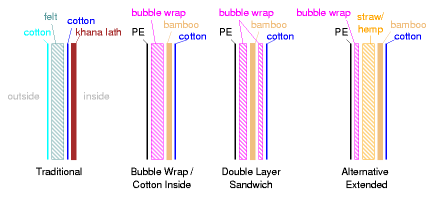
Examples of Insulation Layers of the Wall |
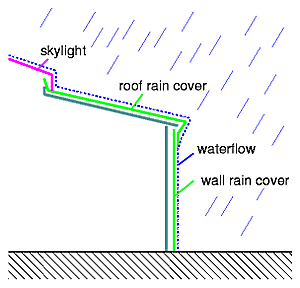
 Waterflow of on the rain covers |
I used light (180g/m 2) Polyethylen (PE) as rain cover, it has limited longlivity under UV radiation (up to 3 years), so it might require some protection with nylon or a thin cotton cover. You can also use heavy PVC as used for truck trailers, those are 600g/m 2 and last 30 years under UV radiation.
On the left you see the overall setup of the rain cover setup, skylight reaching over the roof rain cover, which again goes over the wall rain cover.
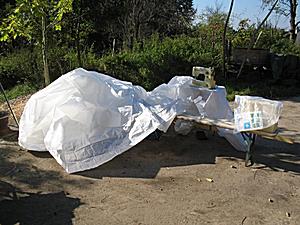 Sewing the roof canvas/cover
2005/10/13 13:40 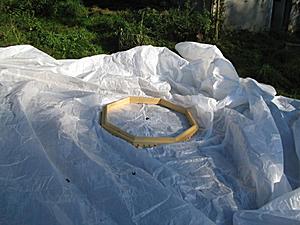 Roof cover and toono/crown-wheel
2005/10/13 15:01 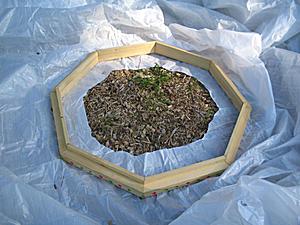 Cutting hole into roof cover
2005/10/13 15:11  Final roof cover cut, 3-4cm left to the toono, sewing then a seam with cord
2005/10/13 15:22
Cotton/polyester canvas is heavy and difficult to sew together, industrial sewing machines required - it's also pricey, but it may be the best choice regarding ecological and longlivity I think.
Felt is surely the preferd heat insulator for a yurt, as it's the traditional insulator. But in western world felt isn't a byproduct but rather industrial manufactured and cleaned beforehand, it also looses water resistance, and only suits as heat insulator, and here in Switzerland industrial felt is pricey. You can make felt yourself out of (moderately) washed raw wool (links how to do this follow), it can be quite a time-consuming undertake.
There are other insulation materials available, best choose one which comes as roll, is bendable, and maybe some heat reflectors build in - those seemed to work best.
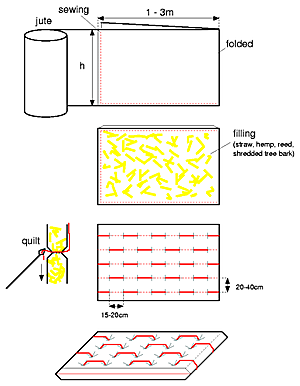
 Quiltet Blanket Insulation |
Claudius Kern, an austrian yurt developer, has made experiences with tree bark split or flakes put into large bags or blankets, and sewed into small compartments (aka quilted) so the flakes don't move and end up at the bottom of the blanket; this way a blanket of 1-3m long, and width of the height of the wall (e.g. 1.5m) are made, and leaned and tied at the top behind the wall / khana. Aside of tree bark also other natural insulator can be used (e.g. hemp, straw, reed), and I'm thinking using straw. It might be necessary to protect such a blanket from receiving moisture, e.g. insulate the blanket inside against water before it's filled, I consider to use bubble wrap in front and behind the blanket as moisture blocker.
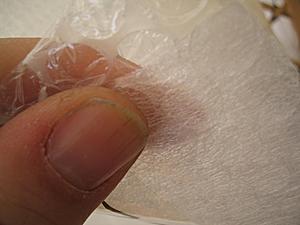
 Double Layer Bubble Wrap |
Anyway, for my first yurt (fall 2005) I ended up using bubble wrap as insulator, first two layers each 0.5cm think, but later added two additional layers, so totally 4 layers. It's 1.50m wide, my wall height, for the roof I patched multiple lanes together with clear tape.
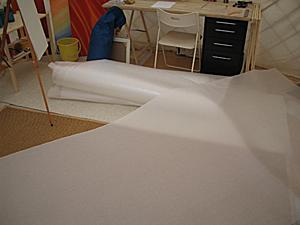 Cut lanes to compose the circular layer (patched) - piled up
2006/01/07 11:07 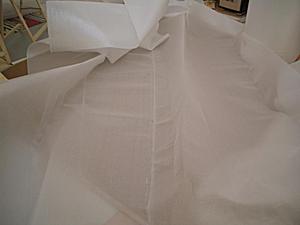 Patching the layers together with clear tape (might be better to simply sew them together, might be more stable)
2006/01/07 12:05 -->
As you can read in my yurt diary the insulation isn't sufficient truly for winters with temperatures below -5°C, and more and better insulations required. A big advantage of the bubble wrap is that it lets the yurt remain daylight bright at the day with the translucent wrap, but for the cost of insufficient insulation for winter time.
So, I personally make another test with truly thick bubble wrap (3cm large bubbles and 1.5cm thick a layer), and also have thermal insulation inside the lattice wall / khana, and then the cotton most-inside, this way the air between the khana laths operates as insulation layer too.
For the winter 2006/2007 I use straw filled jute blankets:
- prepare a wodden needle (apprx. 25cm long) with a 3mm hole at the end - to sew with 2mm cord
- sew two sides, one side is folded, one side remains open (e.g in my case 340cm x 180cm)
- hang up "bag", and fill with open straw, for now one bale of straw, close bag by sewing last side
- lay on the ground and distribute straw evenly as possible (320cm x 160cm)
- start to sew lanes (lengthwise compartments), 4 lines per 160cm width (each apprx.35cm) as I don't really need horizontal compartments since I hang the blankets, only vertical move prevention. Detail: interwave quilts apprx. 10-15cm max, and finally pull on cord tightly before ending it.
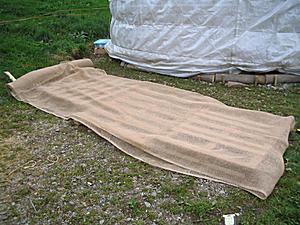 Laying out the jute, aprx. 350cm x 180cm, folded
2006/11/03 08:45 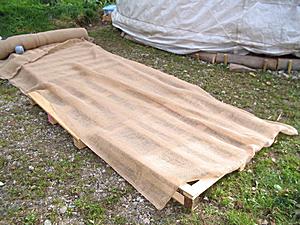 Handsewed bottom and other short side, leaving one side open to fill straw
2006/11/03 09:17 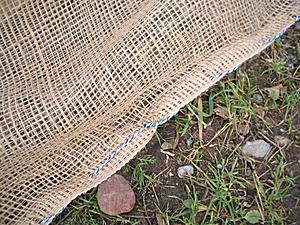 Handsewing with 2mm cord (Closeup)
2006/11/03 09:17 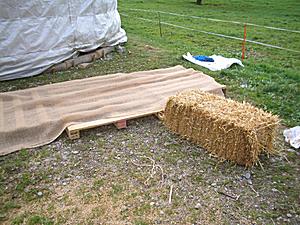 Strawbale
2006/11/03 09:30 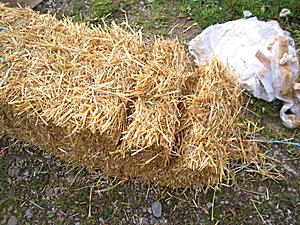 Strawbale slices
2006/11/03 09:31 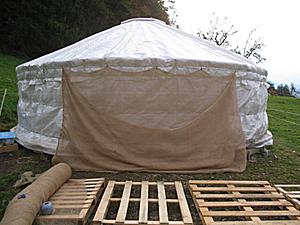 Hanging up the blanket to fill straw
2006/11/03 09:34 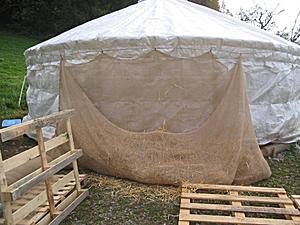 Filling in straw
2006/11/03 09:38 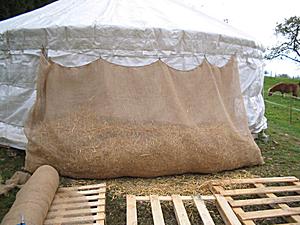 Done filling one strawbale, sewed top
2006/11/03 09:50 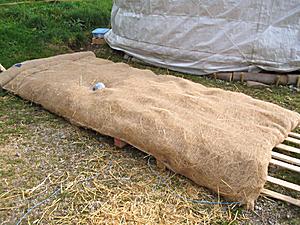 Laying down the blanket and distribute straw as evenly as possible
2006/11/03 10:47 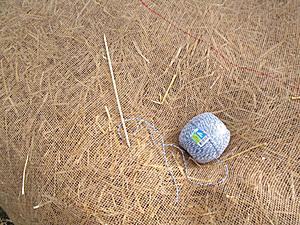 Handmade wodden needle with 2mm cord
2006/11/03 10:47 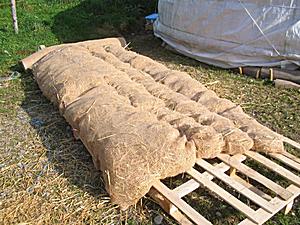 Sewing lines (not really compartments)
2006/11/03 12:55 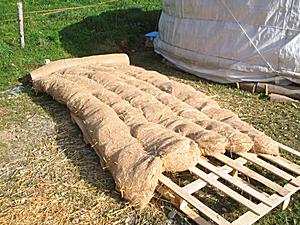 Total 4 lines sewed, 5 lanes
2006/11/03 13:05 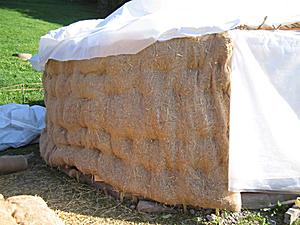 First straw filled jute blanket
2006/11/04 11:42 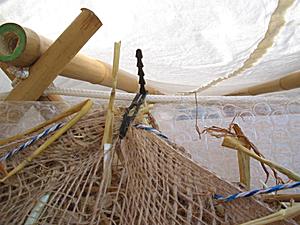 Fixation binder, very useful (Closeup)
2006/11/04 11:42 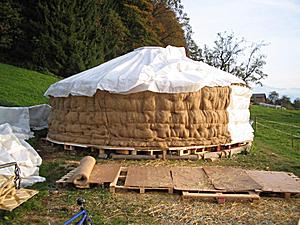 2006/11/04 14:52
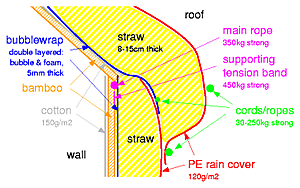
 Thermal Insulation (Wall/Roof Junction Detail) Winter 2007/2008 |
One strawbale (apprx. 100cm x 45cm x 35cm = 0.15m3 compact straw) opened gives 10cm thickness of 5.28m2 which makes 0.528m3 (an increase of 350% of volume when straw is opened), flat from 6.3m2, width and height decrease of apprx. 20cm.
I intentionally did 160cm height (extra 10cm) to my 150cm wall height, to have some left-over.
I reduced the yurt diameter by 20cm to have 10cm spare for the new thermal insulation, this caused the roof be steeper, an advantage when for snow on the roof likely slide easier than before.
In late springtime I will remove the straw blankets til next winter season.

 Reusing Bubblewrap Summer/Winter |
Winter 2007/2008 I realized to narrow the bubblewrap section, since the much lighter part 1/4 of the roof didn't push down as much as the oposite side of the roof, which made the crown-wheel tilt, not much maybe around 5cm but this meant also the directional force from the roof poles applying unwanted vertical tension on the crown-wheel, and in case of a storm not good at all.
So I decided add two more roof segments and leave one segment as bubblewrap - to achieve almost perfect balance on the entire roof, and this way reduce vertical tension on the crown-wheel.
In USA & Canada it's quite popular to use a foil which is thin and reflects heat radiation, achieving good "R" values, yet being 2-5mm thick at maximum.
I recommend you use such foil which passes moisture, e.g. "Reflectix  " is name of such a product among others. " is name of such a product among others.

 My Yurt Interior |
The interior layer doesn't provide that much insulation, but rather is for decorative reasons, e.g. raw cotton canvas, light enough to handle it easily. I prefered the have the roof canvas above the roof poles, but the wall canvas inside and covering the lattice wall - you still see the wall a bit.
| Brightness |
     |
| It's extremely bright, as long the sun is out no lights are required. |
| Thermal Insulation of Cold |
     |
| With 4 layers of 0.5cm bubble-wrap only 10-15°C can be insulated. |
| Thermal Insulation of Heat |
     |
| During summer-time the inside gets very warm, even hot - door and skylight needs to be opened, but if you are away and have to keep all closed it can reached over 20°C plus outside temperature, e.g. 30°C in the shade, can reach over 50°C inside. I used bamboo as wall and roof poles, and due their brown color they got warm, maybe 40-45°C and increased the probability to crack/split length-wise, which per-se does not compromise their stability. |
Summary: Ideal as spring to fall approach, not suitable for below -5°C as too much heating is required. It is highly recommended to use UV resistant bubblewrap otherwise it won't last long, max. one summer season only.
Application: working room, living room from 10°C without heating source, down to -5°C with heating source
| Brightness |
     |
| It's completely dark, with apprx. 10-15cm thickness as I tested there is no sunlight reaching the inside of the yurt anymore. |
| Thermal Insulation of Cold |
     |
| With 10-15cm open straw filled in jute blankets very good insulation is achieved, e.g. 1°C drop per hour when outside is 10-15°C colder than inside. So heating with stove til 22:00 up to 22-24°C still let's you have 12°C in the morning, at 0°C outside temperature. |
| Thermal Insulation of Heat |
     |
| So far the insulation of heat is alike, but no summer season has been yet tested with this setup - so expect an update on this aspect in April/Mai 2007. |
Summary: Straw filled jute blankets are an very cost-effective approach - thermal insulation is good, humidity absorbtion seems good as well - expect update within the next month on this as well.
Application: living room, working room for winter seasons.
| Brightness |
     |
| It's completely dark, with apprx. 4cm thickness there is no sunlight reaching the inside of the yurt. |
| Thermal Insulation of Cold |
     |
| With 4cm hemp boards they insulate moderately to good, not as much as expected. Faster temperature drop after no heat source is available. More details follow. |
| Thermal Insulation of Heat |
??? |
| Unknown, expect update |
Summary: too early to tell, but expect update soon
Application: dito
| Brightness |
     |
| It's completely dark, with apprx. 10-25cm thickness there is no sunlight reaching the inside of the yurt. |
| Thermal Insulation of Cold |
     |
| With 10-25cm thickness of open wool quilted in jute blankets |
| Thermal Insulation of Heat |
??? |
| Unknown, expect update |
Summary: too early to tell, but expect update soon
Application: dito
Next Page >>
Content: - Page 1: Introduction, Mongolian Terms, Yurt Details, Yurt Math
- Page 2: How to Calc, Yurt Calculator, Canvas, Costs
- Page 3: Wheel / Toono, Traditional, 8 Segment Wheel, Multiple Layers, Crownless, Other Ways, Roof Weight ...
- Page 4: Wall / Khana, Bamboo Lattice Wall, Flat Timber Lattice Wall, Termination of Wall Sections ...
- Page 5: Insulation, Rain Cover, Thermal Insulation, Interior, Case Rating 1: Bubble-Wrap & PE Rain-Cover ...
- Page 6: Stove, Fan, Floor, Floor Layers, Attached Room, Math, Calculator, Example, Modern vs. Traditional ...
- Page 7: Erect the Yurt, Preparing the Ground, Floor, Lattice Wall, Crown-Wheel, Layers, Ropes & Tension Ribbons ...
|







































